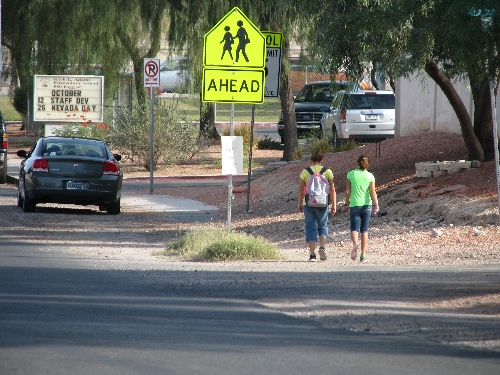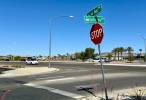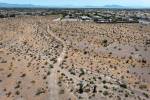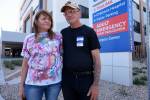Walkers, wheelchair-bound challenged by poor sidewalks, lighting
A series of local used car commercials repeatedly asked the question, "Why are you walking when you could be driving?" The answer was that the customer simply hadn't heard how easy it was to get a car.
Whether car ownership is simple or not, many choose to walk, despite the fact that much of the valley was built for cars.
The Sunrise/Whitney area includes a wide range of walking environments, from the edge of the city of Las Vegas with sidewalks and walk signals to well-established rural communities where pedestrians share the roadside with equestrians.
Community activist Martin Dean Dupalo lives in the former and was inspired by a chance observation while driving in his Sunrise-area neighborhood.
"I was driving on the road and I saw a guy in a wheelchair driving on the edge of the street instead of the sidewalk," Dupalo said. "I thought that the guy was being an idiot and was creating a danger for himself and drivers, but when I saw another person in a wheelchair on the road edge a few days later it made me pause and try to figure out why they were doing that."
On closer examination Dupalo found a haphazard set of sidewalks that made non-automotive travel difficult at best.
"The sidewalks seem to just stop and start randomly," he said. "Sometimes there's sidewalk, sometimes there's dirt. Often there's no ramp on the corners for wheelchairs and strollers to get up. Utility poles choke the sidewalks that are there and make them too narrow for wheelchairs and people with walkers. It was just a mess."
After making a few inquiries and getting nowhere, Dupalo decided to be proactive and acquired a large-scale map of the area where he'd first seen the wheelchair-bound traveler. He then spent three months, sometimes alone and sometimes with friends, surveying the area. They made notes of broken or missing sidewalks and ramps and other hazards to non-vehicular traffic.
"This is the spot where the gang threatened us," Dupalo said, pointing at his heavily annotated map, "and here's where the dog attacked us."
So far, Dupalo has gotten little response from city of Las Vegas officials, although he noted that at least one person running for office is using the sad state of the sidewalks in campaign mailers.
One of Dupalo's points is that the sidewalks are not compliant with the Americans with Disabilities Act. Another area activist is on that bandwagon, too, but Chris Christoff is focused more on bus shelters.
"A lot of people are focusing on the drunk drivers, but that's not the whole problem," Christoff said. "A lot of the shelters are too close to the traffic, and they're not lit up, so they have no identity in the nighttime. Sometimes they're so close to the road that if you're in a wheelchair, you have to go in the street to get past them."
There are large portions of the Sunrise/Whitney area where sidewalks were never considered. In at least one section of Sunrise Manor, they were considered and rejected.
"We've been up here on the hill since 1985. We've owned two places up here," said John Henry Hoffmann, who lives in the foothills of Frenchman Mountain. "It's rural up here, and we like it that way."
Hoffmann and his wife, Gloria, were among the voices resisting the expansion of Hollywood Boulevard in 2001, expanding it to four lanes and adding streetlights and stoplights. Although they lost that battle, their neighborhood east of Hollywood Boulevard remains eclectic and rural.
"There are no walls up here in front of the houses," Gloria Hoffmann said. "Going for a walk is a social thing. You meet your neighbors. Everyone knows everyone up here."
The neighborhood has a commanding view of the valley, and the Hoffmann s have no qualms about strolling the neighborhood, even at night and without sidewalks.
"We come from a rural background, so we know to walk on the left side of the road and keep an eye on oncoming traffic," John Henry Hoffmann said. Gloria Hoffmann concurred.
"Streetlights would spoil the view," she said. "You can't beat it out here on a moonlit night. We don't want to citify our neighborhood."
Clark County Commissioner Chris Giunchigliani's District E includes rural and densely populated areas, including the Strip. She said there are rural neighborhood preservation areas to help keep dark sky, horse access and other rural amenities. The Hoffmanns' home is in an such an area and is protected from unwanted streetlights and sidewalks barring legislation.
"The rest of the valley, including city and county areas, are subject to ADA requirements," Giunchigliani said. "There are way too many parts of the county that aren't compliant."
She cites choked sidewalks and a lack of interconnectivity and many of the same problems Dupalo noticed.
"We've allowed subdivisions with sidewalks on only one side of the street," Giunchigliani said of previous county leadership. "What's that all about?"
Giunchigliani would like to see sidewalks widened to 48 inches starting at the Strip corridor. Currently, many of the sidewalks that are ADA-compliant are only 36 inches wide, which was an earlier standard.
The walkability, or pedestrian-friendliness, of the Las Vegas Valley is poor, according to experts such as Alexander Paz, a civil engineering professor at the University of Nevada, Las Vegas, who also works at the university's Transportation Research Center. Some reasons for this, he said, are the long distances between destinations, wide streets, lack of sidewalks, no shade protection and crime and safety concerns.
"It's a combination of factors, not just the infrastructure," he said. "It's peoples' behavior and interaction."
The only areas of the valley that support walking are downtown and the Strip, he said, and they are the closest thing the valley has to the top walkable cities such as New York City and San Francisco.
"It's pretty dense (in those areas)," Paz said. "There's not that much space. Because the density is there, that helps facilitate the development of transit services."
UNLV student Courtney Coughenour plans to finish her doctorate in public health in May. She is writing her dissertation on the walkability of Las Vegas. She plans to stay in academia and do research on "the built environment and how that influences physical activity and nutrition."
Coughenour is in the process of studying 12 neighborhoods in the valley, both low- and high-income. She will factor in the presence and walking conditions of sidewalks, shade, safety, high-speed streets and more. She said the most interesting finding from her nearly two years of research already is that low-income and older neighborhoods were more walkable compared to high-income and newer ones.
"The new ones we're building aren't very conducive to active living," Coughenour said. "They do have great trail systems ... just not for walking to the store. It's walking for purpose as opposed to walking for leisure."
Coughenour said high neighborhood walls, drainage channels, vacant lots and cul-de-sacs are examples of features that make the area bad for walking. The lack of mixed-use zoning also is a contributing factor.
"Vegas is designed for the automobile, you can't question that," she said.
Timothy Bungum, a public health professor at UNLV, echoed Coughenour's assessment of new neighborhoods.
"Those types of areas are good for pleasure walking," he said. "You can't get to any destination, but they are pretty good for taking a stroll."
Bungum said low walkability is a trend among most newer West Coast cities.
"Cities built after the automobile are pretty bad," he said. "Up until the 1920s, cities were built compactly. After the 1950s, everything has sprawled. City planners in the 1950s began building suburbs. They realized, 'We have just engineered walking out of peoples' lives.' "
New York City, for example, has narrower streets arranged in a grid-type system, and few cul-de-sacs, he said. Bungum said people like to walk in straight lines, and the rule of thumb, according to research, is that almost everyone will walk one-quarter mile to a destination, but few people will walk more than one mile one way.
Giunchigliani said development designs have allowed for bad development and that even when the designs are good, they aren't always followed. She recalled that in her first zoning meeting, a developer asked for forgiveness because his company had not followed its own plans and had left out the sidewalks. She said that despite her objections, the variance passed.
"How do you have a community when you don't have sidewalk connectivity?" Giunchigliani said. "This is where we should have been putting our money during the boom years."
Contact Sunrise/Whitney View reporter F. Andrew Taylor at ataylor@viewnews.com or 702-380-4532.






















